Response to legislator regarding our “Demand Reliable Energy!” petition
After the Texas blackouts, American Experiment launched a campaign to educate Minnesotans about the importance of reliable energy and share that message with elected officials. In total, we’ve sent more than 2,000 messages to lawmakers demanding they prioritize reliable energy sources.
Some lawmakers have written back defending wind and solar, and questioning the validity of the letter we wrote, including my own legislator. I’ve included her email back to me and produced a paragraph-by-paragraph response.
Because many of the lawmakers replies sent by lawmakers have identical paragraphs, you can use the responses below to respond to your legislator, if you wish.
The exact text my legislator sent to me is pasted below and appears unedited:
Dear Isaac:
Thanks for the email regarding the recent weather events and energy crises in the United States. I appreciate the time you took to write me.
First, I should be clear we do not live in Texas. Here in Minnesota, we have something Texans did not, we belong to a grid system that we share with other states. This builds redundancy and resiliency across the grid, meaning if a plant goes down across the border, Minnesota can share its energy with our neighbors. The converse is also true, if a tornado were to damage a plant here our neighbors could help up. This is a smart plan often part of a larger Disaster Recovery Plan and is common practice when assessing energy needs.
It should also be noted that Minnesota has a mix of energy types. We have seen a greater shift in recent years to other forms of energy that are cleaner, cheaper, and reliable. This change is primarily driven by two big factors – consumers have clearly asked for cleaner energy to keep the pristine air, water, and beauty of Minnesota as it is for generations to come. The other key driver is quite simply cost, while wind and solar are the cheapest sources of energy to produce and the cleanest we have also seen natural gas emerge as a cheaper source of energy.
Consumer demand for more budget friendly options and a cleaner environment pared with better and better technology that has become increasing cheaper to produce are good business. Here in Maple Grove Great River Energy is a leader in this space, we are also home the Rural Electric Association and some of our residents are high ranking members of Xcel Energy (including my neighbor). The race to cleaner energy is being driven by the market and consumer preferences. Each of these will tell you the same thing, their biggest barrier is energy storage not a lack of energy options or reliability. The good news on that front is the technology is accelerating at a tremendous rate and storage options are progressing quickly. Solar panels now produce more energy that even those created a few short years ago by a mile, turbines are more efficient, cheaper, and reliable (with features that account for weather). In the interim, Minnesota’s energy needs are well met with a full variety of options with an emphasis on stability, reliability and redundancy balancing lower costs to consumers.
While I appreciate your perspective outlined in your letter, I personally believe that the dire situations in Texas resulted from lack of State involvement (oversight) and investment in their energy infrastructure. It is unfortunate that in the wake of the crisis, the Governor of Texas did not work with local experts to review what went wrong across the state’s energy sources and erroneously indicated that the primary cause of the outages was frozen wind turbines and solar panels, reports indicate that wind turbine shutdowns accounted for a small portion of the state’s energy production, only 13% of the outages. As reported by CNN,
According to a report from ERCOT [Electric Reliability Council of Texas], solar accounts for only 3.8% of the state’s power capacity throughout the year. Wind energy accounts for 10% of Texas’s winter energy capacity and throughout the entire year it is able to provide 24.8%.
If you’d like to read the full article, here is the link: https://www.cnn.com/2021/02/19/politics/texas-energy-outage-wind-turbine-blame-green-energy-fact-check/index.html
It should also be noted that wind turbines can be effectively operated in cold weather, in fact the largest generator of wind energy in the county is our neighbors to the west in the Dakotas, where they operate year-round, including frigid temperatures. The turbines in Texas do have options that allow them to stand up to cold weather, however, the models with these features were deemed more expensive and unnecessary when they were purchased. In other words, Texans felt that turbines with cold weather features cost too much and were not worth their investment. In fairness to Texas, they do not have a great deal of cold weather. I certainly understand their decision but unfortunately, while rare, these conditions historically can and do occur. I do hope that state officials will consider this in their planning for the future.
In addition to highlighting the importance of investments in state infrastructure, the recent events in Texas also shed light on the need to address the changing climate. There is scientific consensus that climate change, caused by human activity, is at a crisis stage. Here in Minnesota as well as across the planet, we are experiencing extreme weather events (such as the recent southern winter storms, hundred-year floods, and record-high temperatures, while here at home we have seen greater moisture leading to delays getting seeds in the ground, mold and mildew on crops destroying part of the yield, a tougher time harvesting in the fall when the income crops generate make or break a farm. In area rivers and streams, it means aging infrastructure like bridges are carrying the weight of waters near flood stage year-round which they were not designed to do). I believe all Minnesotans deserve access to reliable energy infrastructure, clean air, and clean water, which is why I support passing polices that both prevent and prepare for disasters, natural and energy alike.
In your note you stated, “Instead of mandating more wind and solar on to Minnesota’s grid, legislators should put reliable energy first. They can do this by legalizing new nuclear power.” To be frank, this prospect concerns me. Nuclear plants are expensive to build; more expensive to maintain over time than other forms of energy and generate toxic waste for which there is no long-term storage solution. In addition, they are prime targets for terrorist attacks; result in devastating public health consequences should there be an accident; and diverts investments from legitimate clean energy options, like wind and solar.
It is also important to note that the Prairie Island Indian Community is the closest positioned community in the nation to a nuclear power plant, and the toxic risks associated with its operation. Research confirms that environmental threats disproportionately impact Indigeonous people, people of color, and lower income individuals. Far too often a power plant, garbage incinerator, pipeline, or some other type of risky facility that some communities don’t want in their backyard is placed within lower income neighborhoods — leaving those residents left to navigate the toxic burdens on their own. Frankly, this is a form of environmental racism and must be addressed. Thus, finding solutions to nuclear waste storage is a critical part of the conversations about lifting the current prohibition on building new nuclear plants. If you’d like to learn more about the history of the nuclear waste debate in Minnesota, I invite you to visit this link: https://www.lrl.mn.gov/guides/guides?issue=nuclearwaste.
If that were not enough reason, when polluted sites need clean-up it is often the taxpayers who end up footing the bill. I think our communities expect us to be good stewards or their money. Nuclear energy is simply not consistent with needs of our communities or our families.
With that as background, at this point, I can’t predict whether reforms to this area of the law will surface in the Legislature this session. If they do, I will certainly give them the thoughtful consideration that they warrant while keeping your comments in mind.
Again, thank you for contacting me. I appreciate hearing from you. Please stay in touch and stay safe!
Sincerely,
Kristin BahnerState RepresentativeHD 34B
Here is my reply, which includes her original paragraphs.
Dear Representative Bahner,
Thanks for your reply! I appreciate hearing your perspective. However, several statements in your letter are not factually accurate, and I’m happy to help fill in some of the gaps in your analysis.
In your reply, you wrote:
“First, I should be clear we do not live in Texas. Here in Minnesota, we have something Texans did not, we belong to a grid system that we share with other states. This builds redundancy and resiliency across the grid, meaning if a plant goes down across the border, Minnesota can share its energy with our neighbors. The converse is also true, if a tornado were to damage a plant here our neighbors could help up. This is a smart plan often part of a larger Disaster Recovery Plan and is common practice when assessing energy needs. “
I agree that we don’t live in Texas! But this response seems to imply that the blackouts in Texas could have been avoided if the state’s grid, the Electric Reliability Council of Texas (ERCOT), was interconnected with those of other states and subject to federal oversight from the Federal Energy Regulatory Commission (FERC).
While ERCOT’s isolation from other regional power grid does prevent Texas from importing power during events like this, being connected to other grids would not have helped in this specific circumstance because rolling blackouts were also affecting the 14-state Southwest Power Pool at the same time as the Texas blackouts, meaning these states would have had no excess electricity to spare during the Texas emergency.
Areas of the Midcontinent Independent Systems Operator (MISO), the grid system to which Minnesota belongs, also had blackouts in the Southern region, which includes Arkansas, Louisiana, Mississippi, and Southeast Texas.
This means even if Texas had been hooked up to other regional grids, it would not have been bailed out by them during the blackouts because you can’t import power from states that don’t have any to spare.
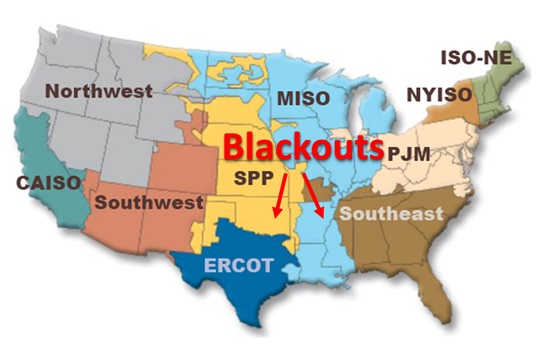
This is why California experienced blackouts in August of 2020. California is connected to other states but still experienced blackouts because it has shut down many of its reliable nuclear and natural gas plants and is overly reliant upon wind and solar power and electricity imports. California was connected to other states, but Arizona and Nevada didn’t have any power to spare, so California went dark.
The lack of reliable generation capacity in California was not a result of poor planning. It was the result of political decisions that led to the shutdown of the Golden State’s nuclear and natural gas plants in favor of wind and solar, despite warnings from the California grid operator that there would be a supply shortfall if there were a region-wide heatwave.
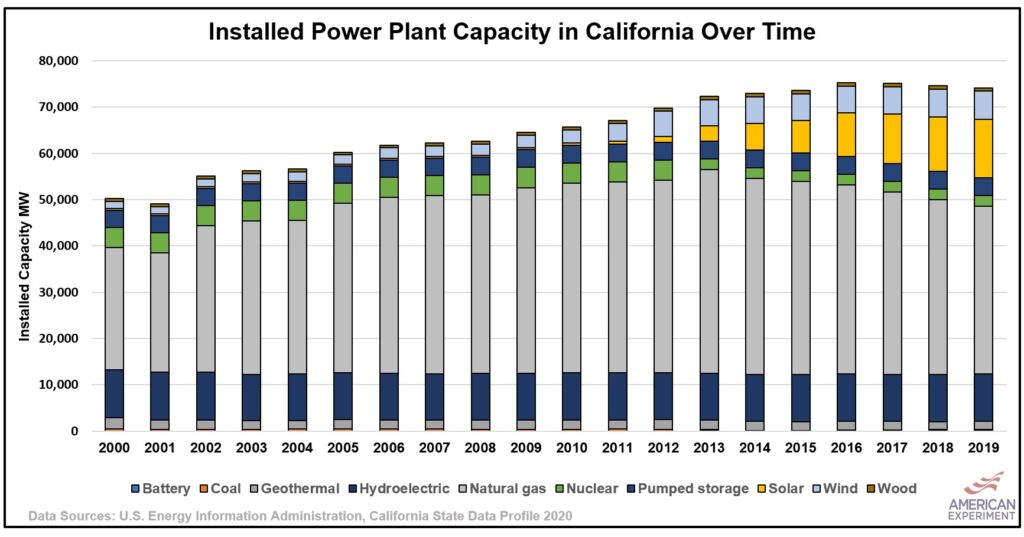
Politics trumped physics, and the people paid the price.
Being interconnected with other states on a regional does not necessarily mean we will be less subject to blackouts in the future. Our whole region will be at greater risk of the rolling blackouts seen in California, Texas, and SPP if we continue to close down our reliable coal plants and rely on increasing amounts of wind and solar power without enough reliable natural gas, nuclear, or hydroelectric power available to fill in the gaps.
You also wrote:
“It should also be noted that Minnesota has a mix of energy types. We have seen a greater shift in recent years to other forms of energy that are cleaner, cheaper, and reliable. This change is primarily driven by two big factors – consumers have clearly asked for cleaner energy to keep the pristine air, water, and beauty of Minnesota as it is for generations to come. The other key driver is quite simply cost, while wind and solar are the cheapest sources of energy to produce and the cleanest we have also seen natural gas emerge as a cheaper source of energy.”
Minnesota has some of the cleanest air in the country, and this was achieved by installing pollution control equipment on our existing coal and natural gas plants and implementing technologies like catalytic converters on cars, not by switching to wind and solar. Pollution control equipment on fossil-fuel power plants and cars allowed Minnesotans to minimize the impact of our energy use on the environment while maximizing the economic gains that affordable energy provides us.
Unfortunately, Minnesota’s electricity is becoming more expensive and less diverse because of government mandates for wind and solar power, federal subsidies, and profit-seeking behavior from monopoly utilities like Xcel Energy.
The graph below is from the U.S. Energy Information Administration, and it shows electricity prices in Minnesota compared to the national average. Minnesota’s electricity prices have increased 23.4 percent more than the national average since Minnesota’s renewable energy mandate was signed into law in 2007.
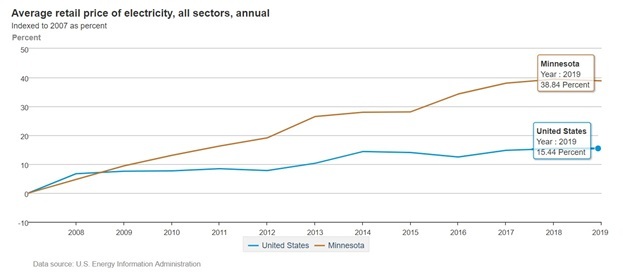
Prices have gone up because wind and solar are not lower cost than Minnesota’s existing coal, natural gas, or nuclear power plants, despite the typical talking points from renewable advocates.
The graph below shows real-life cost data from FERC for Minnesota coal, natural gas, and nuclear plants. The cost assumptions for wind and solar are from Bloomberg New Energy Finance. As you can see, Minnesota’s coal, natural gas, and nuclear plants are some of the lowest-cost electricity sources in the state.
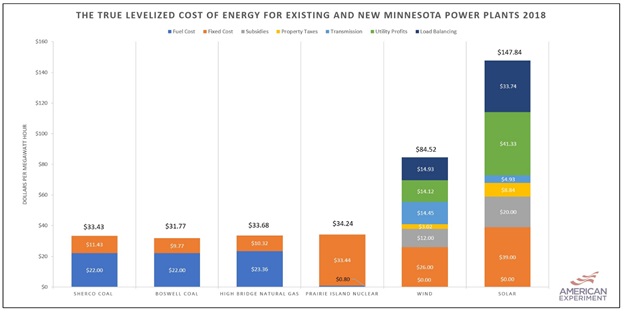
When people say that wind is cheaper than coal, natural gas, or nuclear power in Minnesota, they are quoting the subsidized cost of the energy. Solar is more expensive than traditional sources even after receiving federal subsidies because Minnesota’s solar panels are not very productive.
It’s also important to understand that a simple metric like the Levelized Cost of Energy (LCOE) does not do an adequate job of accounting for the other costs that accompany building more wind turbines and solar panels.
For example, wind and solar require more transmission infrastructure to be built to transport the electricity generated at distant wind and solar farms to the Twin Cities. However, this additional cost is seldom discussed when comparing the cost of solar and wind to traditional power plants.
Wind and solar also require “backup” generation because they only generate electricity on a part-time basis. In Minnesota, Energy Information Administration data show that wind turbines produced just 32.6 percent of their potential electricity output, and solar produced just 17.3 percent on average.
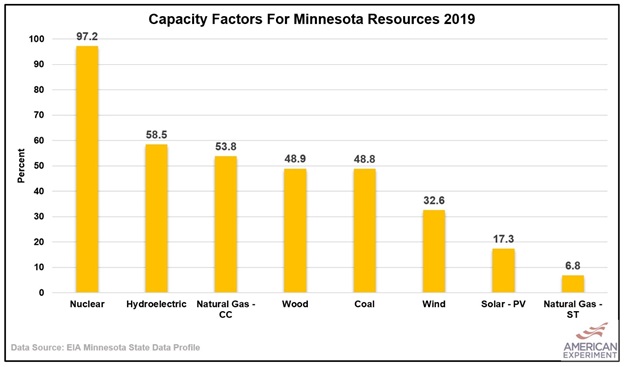
Unlike coal or natural gas plants, which could have produced more electricity if we had needed it, wind and solar produced as much as they could have, weather permitting. This means we will need to build natural gas power plants to “back up” the wind turbines and solar panels to ensure we have electricity when the weather doesn’t cooperate. Building wind turbines, solar panels, and backup plants is very expensive.
Unfortunately, Minnesota’s mix of reliable power is declining as coal plants in the state are shut down several years before the end of their useful lifetimes. This means Minnesota will become increasingly reliant upon natural gas backup when the wind isn’t blowing, or the sun isn’t shining.
The graph below shows Minnesota’s electricity mix in 2020 and compares it to a theoretical day in the future with low wind and solar output. As you can see, there will be times when Minnesota’s fuel supply will be less diverse when our coal plants are shut down because wind and solar cannot produce electricity when the weather isn’t cooperating.
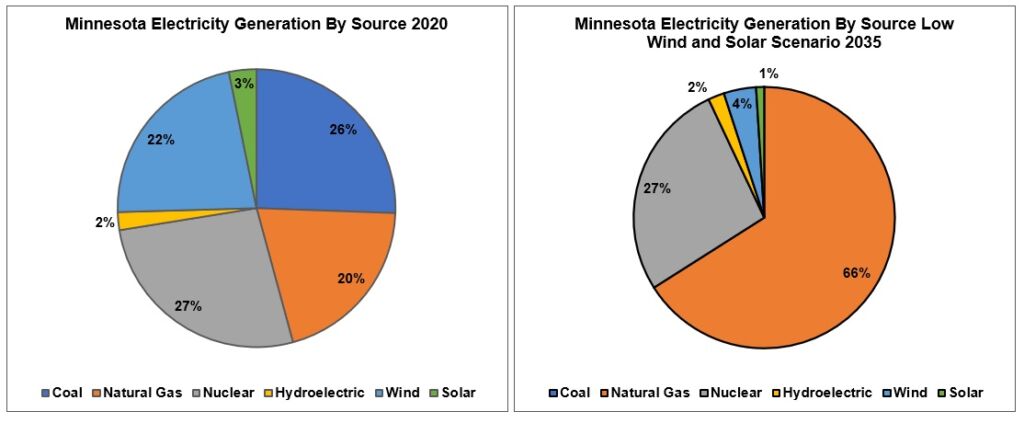
This will greatly increase Minnesota’s reliance on natural gas for electricity generation, which is one reason why Texas experienced blackouts. Competition for natural gas for home heating and electricity production will potentially lead to scarcity, resulting in large spikes in natural gas bills, as we saw in February of 2021, or blackouts.
You wrote:
“Consumer demand for more budget friendly options and a cleaner environment pared with better and better technology that has become increasing cheaper to produce are good business. Here in Maple Grove Great River Energy is a leader in this space, we are also home the Rural Electric Association and some of our residents are high ranking members of Xcel Energy (including my neighbor). The race to cleaner energy is being driven by the market and consumer preferences. Each of these will tell you the same thing, their biggest barrier is energy storage not a lack of energy options or reliability. The good news on that front is the technology is accelerating at a tremendous rate and storage options are progressing quickly.”
My question here is simple: Why do you need storage if wind and solar are reliable? Unfortunately, battery storage is a popular but unrealistic idea for mitigating the unreliable nature of wind and solar power.
A recent study from Wood Mackenzie on battery storage concluded there would be around 741,000 MWh of battery storage on the grid globally by 2030. In 2019, Minnesota used 72 million MWh, including imports from North Dakota and Canada. This means the amount of battery storage expected to be in operation globally in 2030 will be able to satisfy about 1 percent of Minnesota’s 2019 electricity consumption.
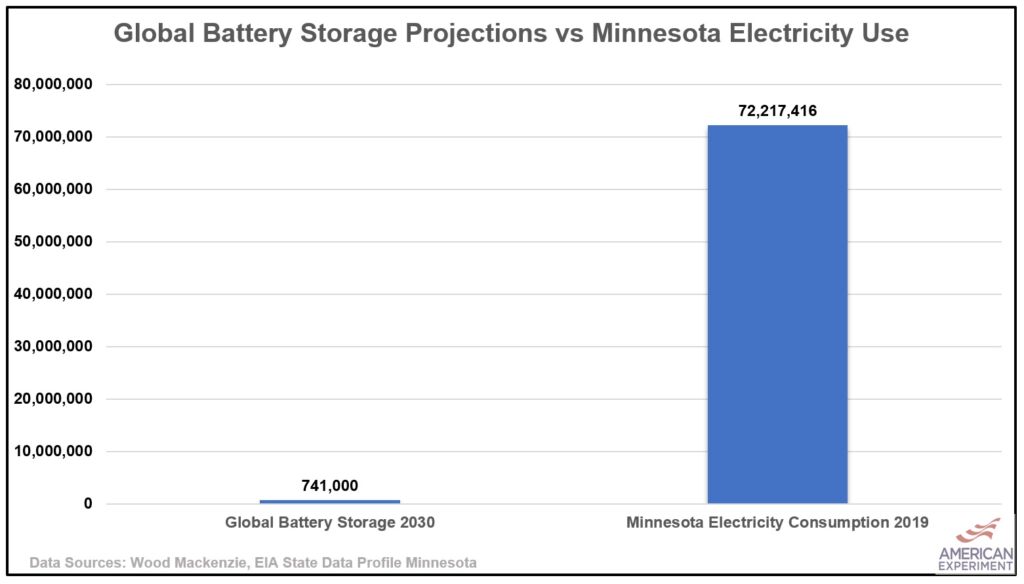
This amount of storage will not be sufficient to provide energy during a future cold snap if wind and solar perform as they did in February. It would also be a terrifying situation to be in. The odds that Minnesota will be the home of all the battery storage built between now and 2030 are also very low.
You also wrote:
“Solar panels now produce more energy that even those created a few short years ago by a mile, turbines are more efficient, cheaper, and reliable (with features that account for weather). In the interim, Minnesota’s energy needs are well met with a full variety of options with an emphasis on stability, reliability and redundancy balancing lower costs to consumers.”
Data from EIA do not support the claim that solar panels are producing more electricity than they did a few years ago. The data show capacity factors have been essentially flat over the last several years. Most of the solar installed in Minnesota occurred after 2015, which should be reflected in rising capacity factors in 2016, 2017, 2018, and 2019 if solar panels truly are making drastic improvements.
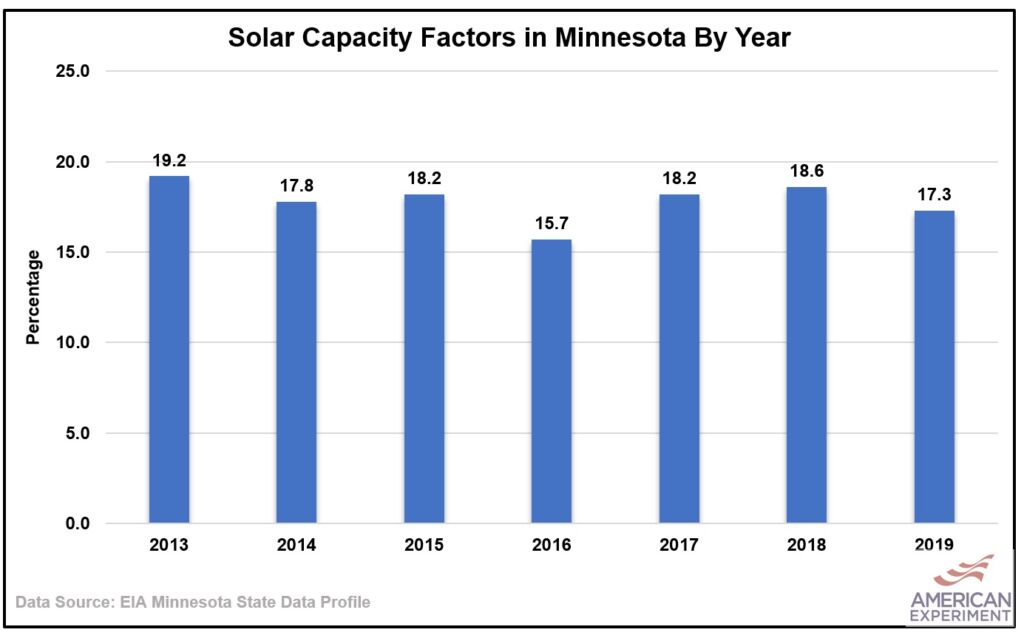
However, the capacity factors of solar panels in Minnesota have been relatively flat since 2015, suggesting that solar panels have not become dramatically better at generating electricity in our state.
You wrote:
While I appreciate your perspective outlined in your letter, I personally believe that the dire situations in Texas resulted from lack of State involvement (oversight) and investment in their energy infrastructure. It is unfortunate that in the wake of the crisis, the Governor of Texas did not work with local experts to review what went wrong across the state’s energy sources and erroneously indicated that the primary cause of the outages was frozen wind turbines and solar panels, reports indicate that wind turbine shutdowns accounted for a small portion of the state’s energy production, only 13% of the outages. As reported by CNN,
According to a report from ERCOT [Electric Reliability Council of Texas], solar accounts for only 3.8% of the state’s power capacity throughout the year. Wind energy accounts for 10% of Texas’s winter energy capacity and throughout the entire year it is able to provide 24.8%.
If you’d like to read the full article, here is the link: https://www.cnn.com/2021/02/19/politics/texas-energy-outage-wind-turbine-blame-green-energy-fact-check/index.html
I agree that the State of Texas did not structure its electricity markets to value reliability or invest in the right kinds of electricity infrastructure. However, the State of Texas was focused on facilitating wind and solar development, not impeding it.
Texas spent more than $7 billion on a transmission line connecting West Texas wind turbines to major metropolitan areas further east. Had Texas invested this money in making sure its natural gas pipes didn’t freeze as temperatures plunged, it may not have experienced blackouts in February.
It’s also important to note that wind turbine production didn’t just fall due to frozen turbines; production also fell due to low wind speeds. The graph below shows wind generation was strong leading up to the blackouts but diminished greatly when the power was needed most.
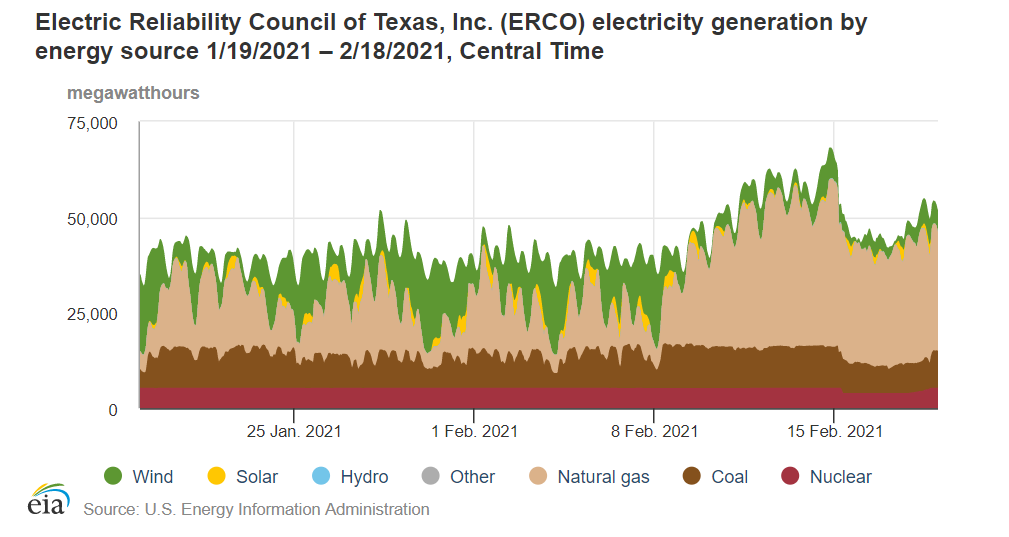
The graph also shows conventional power plants stepped up production to meet rising electricity demand. It is true that natural gas, coal, and nuclear plants experienced significant outages, but they did not fail as badly as wind turbines.
When we look at the capacity factors (the percentage of electricity a power source generated compared to its theoretical maximum) of all generation sources in Texas, wind and solar are clearly the lowest during the period from Feb 15 through Feb 17.
The average hourly capacity factors by electricity source were as follows: nuclear produced 76 percent of its potential, coal produced 39 percent, natural gas produced 38 percent, solar produced 24 percent, and wind produced just 12 percent of its potential output. As a result, nuclear, coal, and natural gas accounted for 91 percent of electricity generation in Texas during this time.

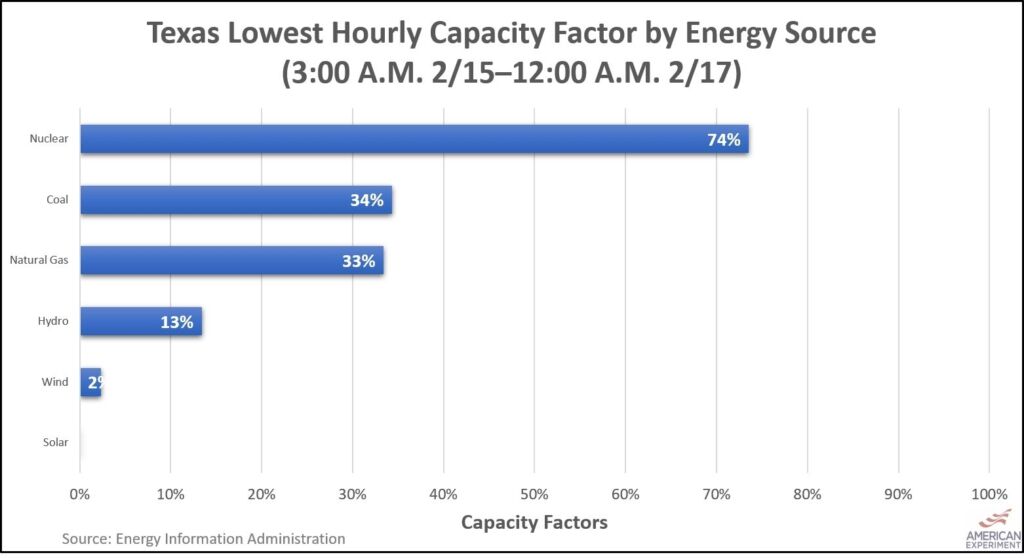
CNN’s article is correct to point out that iced wind turbines accounted for only a small portion of the outages, but focusing on that aspect of the story obscures the bigger picture, which shows wind generation falling dramatically due to low wind speeds.
You wrote:
It should also be noted that wind turbines can be effectively operated in cold weather, in fact the largest generator of wind energy in the county is our neighbors to the west in the Dakotas, where they operate year-round, including frigid temperatures. The turbines in Texas do have options that allow them to stand up to cold weather, however, the models with these features were deemed more expensive and unnecessary when they were purchased. In other words, Texans felt that turbines with cold weather features cost too much and were not worth their investment. In fairness to Texas, they do not have a great deal of cold weather. I certainly understand their decision but unfortunately, while rare, these conditions historically can and do occur. I do hope that state officials will consider this in their planning for the future.
Wind turbines in Minnesota and North Dakota are also affected by cold weather. According to Midwest Energy News, which is run by the renewable energy special interest group Fresh Energy, wind turbines in cold areas automatically shut down when temperatures are -20 °F to keep them from sustaining damage in the cold weather.
At these temperatures, wind turbines actually consume electricity to prevent them from being damaged, meaning the option that allows them to operate at colder temperatures than Texas places extra stress on electricity supplies when we need electricity the most.
Cold weather events like the Polar Vortex are also often associated with low wind speeds, meaning even if wind turbines aren’t automatically shut off, they are unlikely to contribute much electricity in some cold weather circumstances.
We saw this in real-time in February, as wind generation dropped off as temperatures were coldest. If not for the coal fleet on MISO, we could have easily been in a similar situation as Texas or SPP.
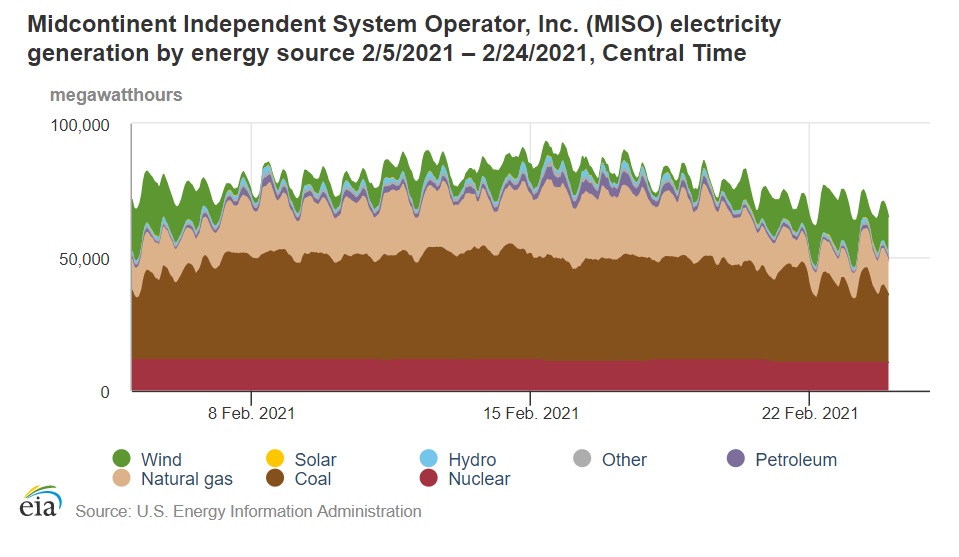
You wrote:
“In addition to highlighting the importance of investments in state infrastructure, the recent events in Texas also shed light on the need to address the changing climate. There is scientific consensus that climate change, caused by human activity, is at a crisis stage. Here in Minnesota as well as across the planet, we are experiencing extreme weather events (such as the recent southern winter storms, hundred-year floods, and record-high temperatures, while here at home we have seen greater moisture leading to delays getting seeds in the ground, mold and mildew on crops destroying part of the yield, a tougher time harvesting in the fall when the income crops generate make or break a farm. In area rivers and streams, it means aging infrastructure like bridges are carrying the weight of waters near flood stage year-round which they were not designed to do). I believe all Minnesotans deserve access to reliable energy infrastructure, clean air, and clean water, which is why I support passing polices that both prevent and prepare for disasters, natural and energy alike. “
I am happy you mentioned this, because academic research in the scientific journal Nature Geoscience finds that Minnesota, North Dakota, and South Dakota are likely to experience a 17 percent decline in wind electricity output due to warming temperatures, which is the largest, in terms of percentage, of any part of the world.
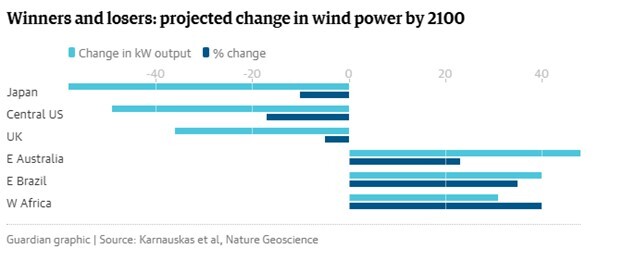
According to climate change models, wind output would fall the most in the northern mid-latitudes because the major driver of wind in these regions is the temperature difference between the Arctic and the tropics. As the Arctic warms, there will be a reduced difference between temperatures in the arctic and the tropics, lowering wind speeds.
If wind speeds fall by as much as they are modeled to fall, wind energy will be more expensive and less available than it is in Minnesota today.
You wrote:
“In your note you stated, “Instead of mandating more wind and solar on to Minnesota’s grid, legislators should put reliable energy first. They can do this by legalizing new nuclear power.” To be frank, this prospect concerns me. Nuclear plants are expensive to build; more expensive to maintain over time than other forms of energy and generate toxic waste for which there is no long-term storage solution. In addition, they are prime targets for terrorist attacks; result in devastating public health consequences should there be an accident; and diverts investments from legitimate clean energy options, like wind and solar.”
I am sorry to inform you that you have been led wildly astray on the safety of nuclear power and its importance for the future. Nuclear plants have large up-front costs, but they produce huge quantities of carbon-free power, regardless of weather conditions, for up to 80 years. Wind turbines, on the other hand, can last up to 20 years, according to the National Renewable Energy Laboratory (NREL), but many are “repowered” before then. Solar panels can last 20 to 30 years.
This means nuclear plants provide a value that is far superior to that of wind or solar.
Also, nuclear power produces less waste than any other source of energy. Despite the fact that nuclear power has provided about 20 percent of America’s electricity for decades, all of the waste produced in the U.S. would fit on a football field stacked in containers stacked 50-feet high.
Nuclear waste is also safely stored in concrete casks at nuclear power plants where they pose no threat to human health and the environment. If not for policies enacted during the Carter administration, the U.S. would be able to recycle spent fuel, as they do in France, to minimize the amount of spent fuel that is stored on-site at nuclear power plants.
Lastly, terrorists know there are much easier ways to kill people, like renting a truck and driving through a crowd of people. A nuclear power plant is likely one of the most difficult targets a terrorist could possibly pick.
I would urge you to learn more about nuclear power and reconsider your position on it. Dr. James Hansen, one of the most preeminent climate scientists in the country, has endorsed nuclear power and argued in The Guardian that it is the only viable path forward on climate change.
You wrote:
It is also important to note that the Prairie Island Indian Community is the closest positioned community in the nation to a nuclear power plant, and the toxic risks associated with its operation. Research confirms that environmental threats disproportionately impact Indigeonous people, people of color, and lower income individuals. Far too often a power plant, garbage incinerator, pipeline, or some other type of risky facility that some communities don’t want in their backyard is placed within lower income neighborhoods — leaving those residents left to navigate the toxic burdens on their own. Frankly, this is a form of environmental racism and must be addressed. Thus, finding solutions to nuclear waste storage is a critical part of the conversations about lifting the current prohibition on building new nuclear plants. If you’d like to learn more about the history of the nuclear waste debate in Minnesota, I invite you to visit this link: https://www.lrl.mn.gov/guides/guides?issue=nuclearwaste.
If that were not enough reason, when polluted sites need clean-up it is often the taxpayers who end up footing the bill. I think our communities expect us to be good stewards or their money. Nuclear energy is simply not consistent with needs of our communities or our families.
This is also incorrect. Nuclear power plants are required to set aside money for decommissioning during their operating lives so taxpayers won’t be left on the hook.
I am also happy that you brought up the concept of environmental justice and environmental racism. Many people do not know that China is the single largest source of solar panels in the world. According to a study in the academic journal Energies, meaning much of the global supply of solar panels is likely manufactured using slave labor from persecuted ethnic minorities.
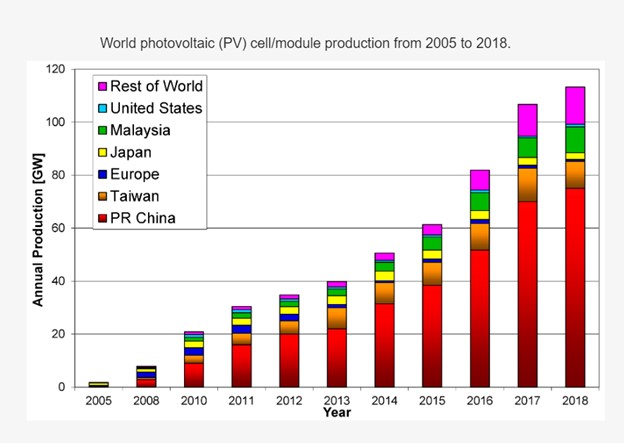
The use of slavery in the production of Chinese solar panels was detailed by The New York Times on January 8th.
“In a flat, arid expanse of China’s far west Xinjiang region, a solar technology company welcomed laborers from a rural area 650 miles away, preparing to put them to work at GCL-Poly, the world’s second-largest maker of polysilicon.”
“The workers, members of the region’s Uighur minority, attended a class in etiquette as they prepared for their new lives in the solar industry, which prides itself as a model of clean, responsible growth. GCL-Poly promoted the housing and training it offered its new recruits in photographs and statements to the local news media.”
“But researchers and human rights experts say those positive images may conceal a more troubling reality — the persecution of one of China’s most vulnerable ethnic groups. According to a report by the consultancy Horizon Advisory, Xinjiang’s rising solar energy technology sector is connected to a broad program of assigned labor in China, including methods that fit well-documented patterns of forced labor.”
“The assertions from Horizon Advisory imply that much of the global solar supply chain may be tainted by an association with forced labor. Such charges could hurt its progressive image and risk product bans from Washington.”
If we are concerned about environmental justice and racism, mandating the use of products that are currently being built by ethnic minorities that are imprisoned and forced to build solar panels is an enormous step in the wrong direction. Indeed, it would make us complicit in these human rights abuses, and guilty of perpetrating a whole new level of environmental racism.
You wrote:
With that as background, at this point, I can’t predict whether reforms to this area of the law will surface in the Legislature this session. If they do, I will certainly give them the thoughtful consideration that they warrant while keeping your comments in mind.
Again, thank you for contacting me. I appreciate hearing from you. Please stay in touch and stay safe!
Sincerely,
Kristin Bahner
State Representative
HD 34B
Likewise!
Isaac